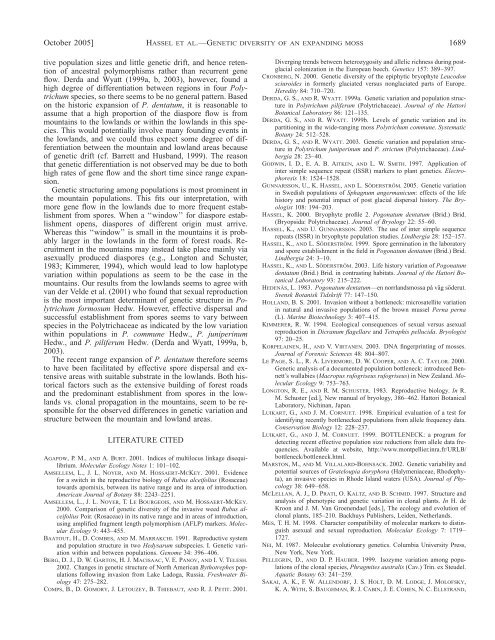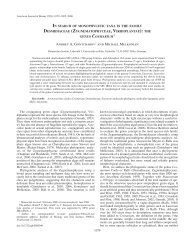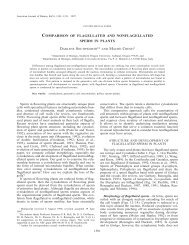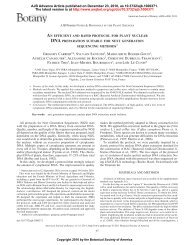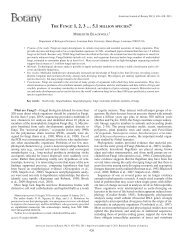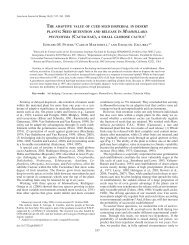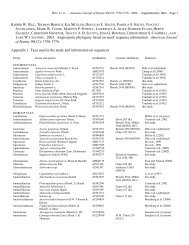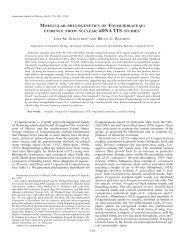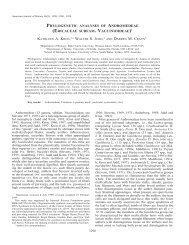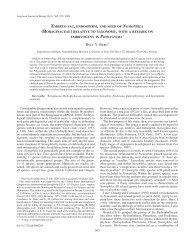genetic variation and structure in the expanding moss pogonatum ...
genetic variation and structure in the expanding moss pogonatum ...
genetic variation and structure in the expanding moss pogonatum ...
You also want an ePaper? Increase the reach of your titles
YUMPU automatically turns print PDFs into web optimized ePapers that Google loves.
October 2005] HASSEL ET AL.—GENETIC DIVERSITY OF AN EXPANDING MOSS<br />
1689<br />
tive population sizes <strong>and</strong> little <strong>genetic</strong> drift, <strong>and</strong> hence retention<br />
of ancestral polymorphisms ra<strong>the</strong>r than recurrent gene<br />
flow. Derda <strong>and</strong> Wyatt (1999a, b, 2003), however, found a<br />
high degree of differentiation between regions <strong>in</strong> four Polytrichum<br />
species, so <strong>the</strong>re seems to be no general pattern. Based<br />
on <strong>the</strong> historic expansion of P. dentatum, it is reasonable to<br />
assume that a high proportion of <strong>the</strong> diaspore flow is from<br />
mounta<strong>in</strong>s to <strong>the</strong> lowl<strong>and</strong>s or with<strong>in</strong> <strong>the</strong> lowl<strong>and</strong>s <strong>in</strong> this species.<br />
This would potentially <strong>in</strong>volve many found<strong>in</strong>g events <strong>in</strong><br />
<strong>the</strong> lowl<strong>and</strong>s, <strong>and</strong> we could thus expect some degree of differentiation<br />
between <strong>the</strong> mounta<strong>in</strong> <strong>and</strong> lowl<strong>and</strong> areas because<br />
of <strong>genetic</strong> drift (cf. Barrett <strong>and</strong> Husb<strong>and</strong>, 1999). The reason<br />
that <strong>genetic</strong> differentiation is not observed may be due to both<br />
high rates of gene flow <strong>and</strong> <strong>the</strong> short time s<strong>in</strong>ce range expansion.<br />
Genetic structur<strong>in</strong>g among populations is most prom<strong>in</strong>ent <strong>in</strong><br />
<strong>the</strong> mounta<strong>in</strong> populations. This fits our <strong>in</strong>terpretation, with<br />
more gene flow <strong>in</strong> <strong>the</strong> lowl<strong>and</strong>s due to more frequent establishment<br />
from spores. When a ‘‘w<strong>in</strong>dow’’ for diaspore establishment<br />
opens, diaspores of different orig<strong>in</strong> must arrive.<br />
Whereas this ‘‘w<strong>in</strong>dow’’ is small <strong>in</strong> <strong>the</strong> mounta<strong>in</strong>s it is probably<br />
larger <strong>in</strong> <strong>the</strong> lowl<strong>and</strong>s <strong>in</strong> <strong>the</strong> form of forest roads. Recruitment<br />
<strong>in</strong> <strong>the</strong> mounta<strong>in</strong>s may <strong>in</strong>stead take place ma<strong>in</strong>ly via<br />
asexually produced diaspores (e.g., Longton <strong>and</strong> Schuster,<br />
1983; Kimmerer, 1994), which would lead to low haplotype<br />
<strong>variation</strong> with<strong>in</strong> populations as seem to be <strong>the</strong> case <strong>in</strong> <strong>the</strong><br />
mounta<strong>in</strong>s. Our results from <strong>the</strong> lowl<strong>and</strong>s seems to agree with<br />
van der Velde et al. (2001) who found that sexual reproduction<br />
is <strong>the</strong> most important determ<strong>in</strong>ant of <strong>genetic</strong> <strong>structure</strong> <strong>in</strong> Polytrichum<br />
formosum Hedw. However, effective dispersal <strong>and</strong><br />
successful establishment from spores seems to vary between<br />
species <strong>in</strong> <strong>the</strong> Polytrichaceae as <strong>in</strong>dicated by <strong>the</strong> low <strong>variation</strong><br />
with<strong>in</strong> populations <strong>in</strong> P. commune Hedw., P. juniper<strong>in</strong>um<br />
Hedw., <strong>and</strong> P. piliferum Hedw. (Derda <strong>and</strong> Wyatt, 1999a, b,<br />
2003).<br />
The recent range expansion of P. dentatum <strong>the</strong>refore seems<br />
to have been facilitated by effective spore dispersal <strong>and</strong> extensive<br />
areas with suitable substrate <strong>in</strong> <strong>the</strong> lowl<strong>and</strong>s. Both historical<br />
factors such as <strong>the</strong> extensive build<strong>in</strong>g of forest roads<br />
<strong>and</strong> <strong>the</strong> predom<strong>in</strong>ant establishment from spores <strong>in</strong> <strong>the</strong> lowl<strong>and</strong>s<br />
vs. clonal propagation <strong>in</strong> <strong>the</strong> mounta<strong>in</strong>s, seem to be responsible<br />
for <strong>the</strong> observed differences <strong>in</strong> <strong>genetic</strong> <strong>variation</strong> <strong>and</strong><br />
<strong>structure</strong> between <strong>the</strong> mounta<strong>in</strong> <strong>and</strong> lowl<strong>and</strong> areas.<br />
LITERATURE CITED<br />
AGAPOW, P.M.,AND A. BURT. 2001. Indices of multilocus l<strong>in</strong>kage disequilibrium.<br />
Molecular Ecology Notes 1: 101–102.<br />
AMSELLEM, L., J. L. NOYER, AND M. HOSSAERT-MCKEY. 2001. Evidence<br />
for a switch <strong>in</strong> <strong>the</strong> reproductive biology of Rubus alceifolius (Rosaceae)<br />
towards apomixis, between its native range <strong>and</strong> its area of <strong>in</strong>troduction.<br />
American Journal of Botany 88: 2243–2251.<br />
AMSELLEM, L., J. L. NOYER, T.LE BOURGEOIS, AND M. HOSSAERT-MCKEY.<br />
2000. Comparison of <strong>genetic</strong> diversity of <strong>the</strong> <strong>in</strong>vasive weed Rubus alceifolius<br />
Poir. (Rosaceae) <strong>in</strong> its native range <strong>and</strong> <strong>in</strong> areas of <strong>in</strong>troduction,<br />
us<strong>in</strong>g amplified fragment length polymorphism (AFLP) markers. Molecular<br />
Ecology 9: 443–455.<br />
BAATOUT, H., D. COMBES, AND M. MARRAKCHI. 1991. Reproductive system<br />
<strong>and</strong> population <strong>structure</strong> <strong>in</strong> two Hedysarum subspecies. I. Genetic <strong>variation</strong><br />
with<strong>in</strong> <strong>and</strong> between populations. Genome 34: 396–406.<br />
BERG, D. J., D. W. GARTON, H.J.MACISAAC, V.E.PANOV, AND I. V. TELESH.<br />
2002. Changes <strong>in</strong> <strong>genetic</strong> <strong>structure</strong> of North American Bythotrephes populations<br />
follow<strong>in</strong>g <strong>in</strong>vasion from Lake Ladoga, Russia. Freshwater Biology<br />
47: 275–282.<br />
COMPS, B., D. GOMORY, J.LETOUZEY, B.THIEBAUT, AND R. J. PETIT. 2001.<br />
Diverg<strong>in</strong>g trends between heterozygosity <strong>and</strong> allelic richness dur<strong>in</strong>g postglacial<br />
colonization <strong>in</strong> <strong>the</strong> European beech. Genetics 157: 389–397.<br />
CRONBERG, N. 2000. Genetic diversity of <strong>the</strong> epiphytic bryophyte Leucodon<br />
sciuroides <strong>in</strong> formerly glaciated versus nonglaciated parts of Europe.<br />
Heredity 84: 710–720.<br />
DERDA, G.S.,AND R. WYATT. 1999a. Genetic <strong>variation</strong> <strong>and</strong> population <strong>structure</strong><br />
<strong>in</strong> Polytrichum piliferum (Polytrichaceae). Journal of <strong>the</strong> Hattori<br />
Botanical Laboratory 86: 121–135.<br />
DERDA, G.S., AND R. WYATT. 1999b. Levels of <strong>genetic</strong> <strong>variation</strong> <strong>and</strong> its<br />
partition<strong>in</strong>g <strong>in</strong> <strong>the</strong> wide-rang<strong>in</strong>g <strong>moss</strong> Polytrichum commune. Systematic<br />
Botany 24: 512–528.<br />
DERDA, G.S.,AND R. WYATT. 2003. Genetic <strong>variation</strong> <strong>and</strong> population <strong>structure</strong><br />
<strong>in</strong> Polytrichum juniper<strong>in</strong>um <strong>and</strong> P. strictum (Polytrichaceae). L<strong>in</strong>dbergia<br />
28: 23–40.<br />
GODWIN, I. D., E. A. B. AITKEN, AND L. W. SMITH. 1997. Application of<br />
<strong>in</strong>ter simple sequence repeat (ISSR) markers to plant <strong>genetic</strong>s. Electrophoresis<br />
18: 1524–1528.<br />
GUNNARSSON, U., K. HASSEL, AND L. SÖDERSTRÖM. 2005. Genetic <strong>variation</strong><br />
<strong>in</strong> Swedish populations of Sphagnum angermanicum: effects of <strong>the</strong> life<br />
history <strong>and</strong> potential impact of post glacial dispersal history. The Bryologist<br />
108: 194–203.<br />
HASSEL, K. 2000. Bryophyte profile 2. Pogonatum dentatum (Brid.) Brid.<br />
(Bryopsida: Polytrichaceae). Journal of Bryology 22: 55–60.<br />
HASSEL, K., AND U. GUNNARSSON. 2003. The use of <strong>in</strong>ter simple sequence<br />
repeats (ISSR) <strong>in</strong> bryophyte population studies. L<strong>in</strong>dbergia 28: 152–157.<br />
HASSEL, K., AND L. SÖDERSTRÖM. 1999. Spore germ<strong>in</strong>ation <strong>in</strong> <strong>the</strong> laboratory<br />
<strong>and</strong> spore establishment <strong>in</strong> <strong>the</strong> field <strong>in</strong> Pogonatum dentatum (Brid.) Brid.<br />
L<strong>in</strong>dbergia 24: 3–10.<br />
HASSEL, K., AND L. SÖDERSTRÖM. 2003. Life history <strong>variation</strong> of Pogonatum<br />
dentatum (Brid.) Brid. <strong>in</strong> contrast<strong>in</strong>g habitats. Journal of <strong>the</strong> Hattori Botanical<br />
Laboratory 93: 215–222.<br />
HEDENÄS, L. 1983. Pogonatum dentatum—en norrl<strong>and</strong>s<strong>moss</strong>a på väg söderut.<br />
Svensk Botanisk Tidskrift 77: 147–150.<br />
HOLLAND, B. S. 2001. Invasion without a bottleneck: microsatellite <strong>variation</strong><br />
<strong>in</strong> natural <strong>and</strong> <strong>in</strong>vasive populations of <strong>the</strong> brown mussel Perna perna<br />
(L). Mar<strong>in</strong>e Biotechnology 3: 407–415.<br />
KIMMERER, R. W. 1994. Ecological consequences of sexual versus asexual<br />
reproduction <strong>in</strong> Dicranum flagellare <strong>and</strong> Tetraphis pellucida. Bryologist<br />
97: 20–25.<br />
KORPELAINEN, H., AND V. VIRTANEN. 2003. DNA f<strong>in</strong>gerpr<strong>in</strong>t<strong>in</strong>g of <strong>moss</strong>es.<br />
Journal of Forensic Sciences 48: 804–807.<br />
LE PAGE, S. L., R. A. LIVERMORE, D.W.COOPER, AND A. C. TAYLOR. 2000.<br />
Genetic analysis of a documented population bottleneck: <strong>in</strong>troduced Bennett’s<br />
wallabies (Macropus rufogriseus rufogriseus) <strong>in</strong> New Zeal<strong>and</strong>. Molecular<br />
Ecology 9: 753–763.<br />
LONGTON, R.E.,AND R. M. SCHUSTER. 1983. Reproductive biology. In R.<br />
M. Schuster [ed.], New manual of bryology, 386–462. Hattori Botanical<br />
Laboratory, Nich<strong>in</strong>an, Japan.<br />
LUIKART, G., AND J. M. CORNUET. 1998. Empirical evaluation of a test for<br />
identify<strong>in</strong>g recently bottlenecked populations from allele frequency data.<br />
Conservation Biology 12: 228–237.<br />
LUIKART, G., AND J. M. CORNUET. 1999. BOTTLENECK: a program for<br />
detect<strong>in</strong>g recent effective population size reductions from allele data frequencies.<br />
Available at website, http://www.montpellier.<strong>in</strong>ra.fr/URLB/<br />
bottleneck/bottleneck.html.<br />
MARSTON, M., AND M. VILLALARD-BOHNSACK. 2002. Genetic variability <strong>and</strong><br />
potential sources of Grateloupia doryphora (Halymeniaceae, Rhodophyta),<br />
an <strong>in</strong>vasive species <strong>in</strong> Rhode Isl<strong>and</strong> waters (USA). Journal of Phycology<br />
38: 649–658.<br />
MCLELLAN, A. J., D. PRATI, O.KALTZ, AND B. SCHMID. 1997. Structure <strong>and</strong><br />
analysis of phenotypic <strong>and</strong> <strong>genetic</strong> <strong>variation</strong> <strong>in</strong> clonal plants. In H. de<br />
Kroon <strong>and</strong> J. M. Van Groenendael [eds.], The ecology <strong>and</strong> evolution of<br />
clonal plants, 185–210. Backhuys Publishers, Leiden, Ne<strong>the</strong>rl<strong>and</strong>s.<br />
MES, T. H. M. 1998. Character compatibility of molecular markers to dist<strong>in</strong>guish<br />
asexual <strong>and</strong> sexual reproduction. Molecular Ecology 7: 1719–<br />
1727.<br />
NEI, M. 1987. Molecular evolutionary <strong>genetic</strong>s. Columbia University Press,<br />
New York, New York.<br />
PELLEGRIN, D., AND D. P. HAUBER. 1999. Isozyme <strong>variation</strong> among populations<br />
of <strong>the</strong> clonal species, Phragmites australis (Cav.) Tr<strong>in</strong>. ex Steudel.<br />
Aquatic Botany 63: 241–259.<br />
SAKAI, A. K., F. W. ALLENDORF, J.S.HOLT, D.M.LODGE, J.MOLOFSKY,<br />
K. A. WITH, S.BAUGHMAN,R.J.CABIN,J.E.COHEN,N.C.ELLSTRAND,


